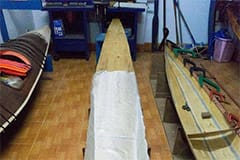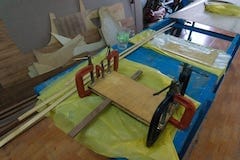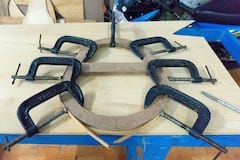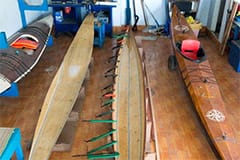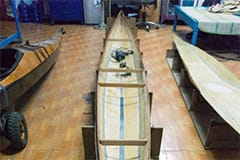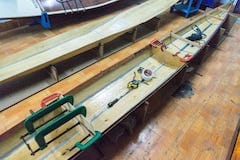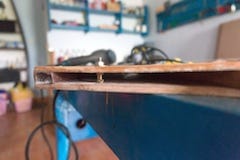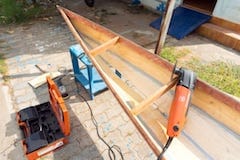 arious miscellaneous jobs in preparing for the next steps. First is glueing the skeg box and glassing the skeg blade (I use the “skeg in a well” as in my last boat, the skeg box is like a “well”, going through hull and through deck, a design that greatly facilitates maintenance and repair). Then forming the cockpit coaming by 2 nested narrow strips of 4 mm plywood, bending around the MDF frame cut earlier, the ply is so fragile that I had to brush it with a layer of epoxy to prevent cracks when bending.
arious miscellaneous jobs in preparing for the next steps. First is glueing the skeg box and glassing the skeg blade (I use the “skeg in a well” as in my last boat, the skeg box is like a “well”, going through hull and through deck, a design that greatly facilitates maintenance and repair). Then forming the cockpit coaming by 2 nested narrow strips of 4 mm plywood, bending around the MDF frame cut earlier, the ply is so fragile that I had to brush it with a layer of epoxy to prevent cracks when bending.
There’re still lots of things to be done before two halves of the peanut shell (a.k.a hull and deck) could be jointed together: fitting the starboard gunwale, fitting and glassing fore and aft bulkheads, install some cross – beam stringers, install the skeg box and it’s control line, making and installing the cockpit as well as the two hatches’ rims, build some lashing anchor points into the hull… any many other unnamed jobs. Forcing myself to slow down as not to let my impatience harm the kayak quality.
5th image below: the stringers glued and screwed in place, these stringers serve multiple purposes: help maintaining the boat width profile, support the skeg box and bulkheads, the stringer right behind the cockpit would help strengthen the deck (as the only way to get into the kayak is climbing upon its aft deck then slide your legs in). 6th image: the fore and aft bulkheads clamped in, ready to be sealed with putty and then glassed. Next would be the important job of installing the skeg box.
Serene – 1 p1
Serene – 1 p2
Serene – 1 p3
Serene – 1 p4
A large part on boat – building here (in Vietnam) is not about learning the techniques and executing them right. Mishaply, it’s about dealing with inferior – quality materials, working around with under – standard chemicals, paints, epoxy and various faulty wood – working tools.
A “secret” in this Serene – 1 kayak design: its lines are all mathematically very well – defined. I don’t know if this would add some gains into the boat’s performance, but in building, it’s easier to draw and cut, easier to stitch and form, less bending, less fastening, less clamping etc…

